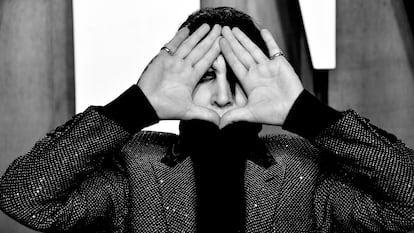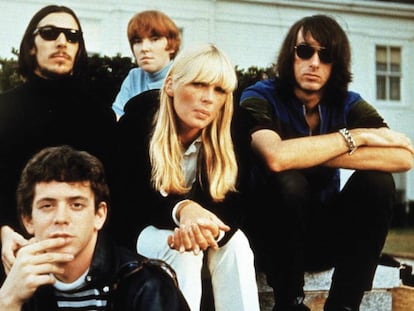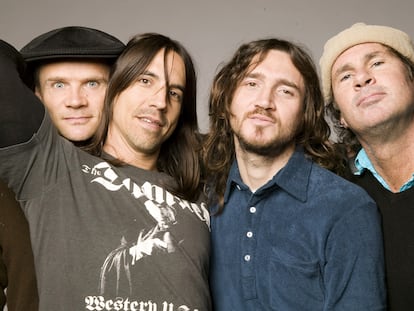Marilyn Manson: the descent into hell of metal’s provocateur
Once celebrated as an avant-garde oddity and courted by Hollywood figures, the musician is in personal and professional decline following allegations of sexual and psychological abuse by former partners
There was a time when Marilyn Manson seduced certain intellectual circles. Illustrious minds with twisted tastes, such as movie-makers David Lynch and Tim Burton, actor Shia LaBeouf, documentary maker and rabble-rouser Michael Moore or industrial rock guru and leader of the band Nine Inch Nails, Trent Reznor. All of them admired the dark personality of Brian Hugh Warner, the Ohio-born Manson’s real name. Lynch once said that he though the musician was a “sensational artist.” Perhaps he was, with albums like the platinum-selling Antichrist Superstar (1997) and songs including The Beautiful People.
But today, Manson’s aura has faded: to his artistic decadence have been added allegations of sexual and psychological abuse by several women, among them former partners including the actors Evan Rachel Wood and Esmé Bianco and the model Ashley Morgan Smithline.
Last month, Rolling Stone published an in-depth investigation centering on the allegations Titled Marilyn Manson: The Monster Hiding in Plain Sight, which contains some terrifying passages. EL PAÍS got in touch with one of the reporters, Kory Grow, who politely declined to comment, “preferring to let the reporting in the article speak for itself.” In the article, several women lay out the alleged abuses they were subjected to. Many of these took place in a tiny, soundproofed room at Manson’s former West Hollywood apartment, which they state the singer referred to as the “Bad Girls’ Room.” Lawsuits have been filed and the investigation is ongoing. Two weeks ago, police raided the singer’s mansion in search of evidence.

The singer’s provocative persona over the course of his 30-year career has now taken on a genuinely sinister tone. In 2009, Manson told The Guardian: “Fear is something I instill in other people, mostly young girls.” Nobody clutched at their pearls. After all, this was Marilyn Manson, a known braggart and provocateur. His first album, Portrait of an American Family (1994), closes with the song Misery Machine. At the end of the song, a voicemail of a mother who is concerned for her son is added in a burlesque tone. At that time, Manson was starting out and in order to stay in touch with his scattering of fans he would ask for their addresses at the end of concerts to send photos and promotional material.
The voicemail message at the end of Misery Machine states: “I want my son off of your mailing list, I have already contacted the post office about your pornographic material that is being received in the mail, my next stop is my attorney. I do not want this number called anymore, and I do not want anything delivered to my address. If I receive anything else from this band, or this group, my next phone call will be my attorney, and you will be contacted. Thank you and good-bye!” Another of the plaintiffs, the model Sarah McNeilly, told Rolling Stone: “The physical violence was almost a relief. Like, the mental shit that he puts you through, that he infects your brain with, that he brainwashes you, you just want it to stop.”
Manson’s success was forged in two directions in the 1990s: towards carving a niche in the metal new wave at the time, and projecting a bloody and gruesome image. His plan was based on provocation and the horrifying videos broadcast on television allowed him to enter the homes of the American public. His attacks on religion, messages about a population alienated by power and a predilection for seedy sadomasochism proved too much for the more conservative families. They placed a target on his back.

At the same time, a group of respected artists felt drawn to his turbulent image and his anti-establishment stance. Among these was Trent Reznor, among whose admirers was David Bowie, who signed him to his record label. And David Lynch, who included Reznor’s cover of a song by Screamin Jay Hawkins, I Put a Spell On You, in his 1997 movie Lost Highway. Manson’s relationship with Lynch ran smoothly for a time: in 2010 they unveiled a joint exhibition called Genealogies of Pain. Manson provided paintings of deformed figures and Lynch created videos to accompany them.
In 2002, Manson participated in Michael Moore’s documentary Bowling for Columbine. During the film there is a segment that acts as a barometer for Manson’s popularity at that time. Searching for an unwitting ideologue for the tragedy that cost the lives of 12 students when Eric Harris and Dylan Klebold, both 18, opened fire at Columbine High School, the far right pointed at Manson. Why? They claimed the shooters were fans of the musician and that his lyrics, his statements and his aesthetic generated a bad influence on them. They did not provide any evidence for this. Moore interviewed Manson in a kind of dressing room hallway, perhaps a makeshift one used during a concert he had performed at a sports complex. While Manson provided explanations as to why he had been singled out, Moore, the scourge of American conservatism, nodded his agreement. Manson had him convinced. He was loquacious, intelligent, a perfect guinea pig used to provide a smoke screen so that a country with high levels of violence that sells assault rifles in supermarkets did not have to hold itself accountable. That was what Moore implied with his nodding assent.

Musically, Manson’s two greatest works were Antichrist Superstar (1996) and Holy Wood (2000). Of the latter, music critic Alec Chillingworth wrote in the seminal magazine for the genre, Metal Hammer: “It is a gigantic artistic achievement that will go down in history as Manson’s defining statement.” But perhaps Manson’s most popular songs are his covers of other bands’ classics, like Sweet Dreams by Eurythmics; Depeche Mode’s Personal Jesus; Tainted Love by Soft Cell, or Patti Smith’s Rock and Roll Nigger.
Manson’s music is best understood in a concrete period, from the mid-1990s to the early 2000s, when heavy metal was modernizing and borrowing the sounds and rhythms of industrial and electronic music. Towards the end of the 2000s, Manson’s popularity was starting to wane. His braggadocio was no longer dangerous and his erratic behavior caused his concerts to descend into the realm of caricature. Reznor had long since distanced himself, telling Mojo magazine: “He is a malicious guy who will cross any line of decency and stamp on anyone’s face to succeed.”

Manson’s lawyers have “categorically” denied the accusations leveled at the singer, and he wrote on Instagram: “My intimate relationships have always been entirely consensual with like-minded partners. Regardless of how – and why – others are now choosing to misrepresent the past, that is the truth.” Dita Von Teese, Manson’s ex-wife, has also offered her opinion in the wake of the allegations: “The details made public do not match my personal experience,” the actor and fashion designer said. When the allegations first came to light, Manson’s manager quit and his record label fired him. The musician has no concerts planned in the next few months.
His last public appearance, on November 1, was striking to say the least. Dressed completely in white, hooded and with his face almost completely covered, Manson joined Justin Bieber and Kanye West in one of the surreal musical masses the rapper holds every three months. West has described these gatherings, which he calls Sunday Service, as a “curative and Christian experience.” And Manson, the cornered messiah of darkness and hell-worship, was right there.
Tu suscripción se está usando en otro dispositivo
¿Quieres añadir otro usuario a tu suscripción?
Si continúas leyendo en este dispositivo, no se podrá leer en el otro.
FlechaTu suscripción se está usando en otro dispositivo y solo puedes acceder a EL PAÍS desde un dispositivo a la vez.
Si quieres compartir tu cuenta, cambia tu suscripción a la modalidad Premium, así podrás añadir otro usuario. Cada uno accederá con su propia cuenta de email, lo que os permitirá personalizar vuestra experiencia en EL PAÍS.
¿Tienes una suscripción de empresa? Accede aquí para contratar más cuentas.
En el caso de no saber quién está usando tu cuenta, te recomendamos cambiar tu contraseña aquí.
Si decides continuar compartiendo tu cuenta, este mensaje se mostrará en tu dispositivo y en el de la otra persona que está usando tu cuenta de forma indefinida, afectando a tu experiencia de lectura. Puedes consultar aquí los términos y condiciones de la suscripción digital.
More information
Archived In
Últimas noticias
Most viewed
- Sinaloa Cartel war is taking its toll on Los Chapitos
- Oona Chaplin: ‘I told James Cameron that I was living in a treehouse and starting a permaculture project with a friend’
- Reinhard Genzel, Nobel laureate in physics: ‘One-minute videos will never give you the truth’
- Why the price of coffee has skyrocketed: from Brazilian plantations to specialty coffee houses
- Silver prices are going crazy: This is what’s fueling the rally












































